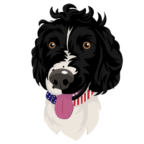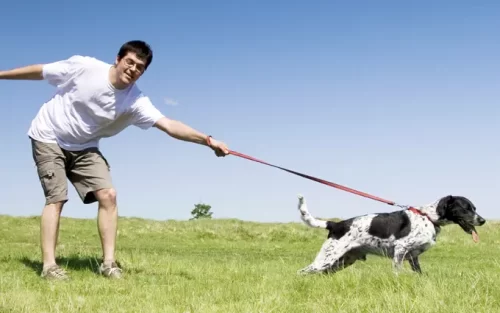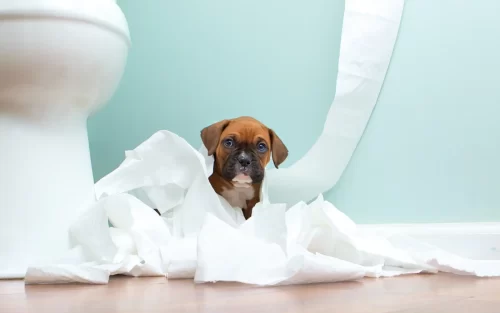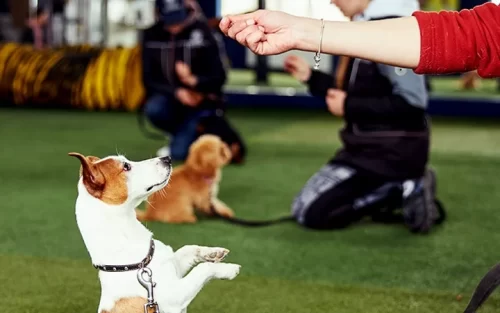As a dog owner, you may meet the common yet frustrating issue of your canine companion chewing on things they shouldn’t. While it’s natural for dogs to chew, destructive chewing can lead to expensive damage and potential dangers for your pet. If that happens then it’s important to prevent your dog from chewing on things that they shouldn’t.
Today we’ll delve into the reasons behind your dog’s chewing habits, discuss how to address the root causes, and provide valuable tips and tricks to prevent it. By understanding their instincts and implementing practical solutions, you can create a harmonious and chew-free home for you and your furry friend.
Understanding Why Dogs Chew
Before tackling the problem, it’s essential to understand why dogs chew in the first place. There are several reasons, including:
- Teething: Puppies, like human babies, experience a teething stage where their baby teeth are replaced by adult teeth. This phase typically occurs between the ages of 4 and 6 months and can last several weeks. Chewing helps alleviate the discomfort and pain associated with this process.
- Boredom: Dogs may chew on things when they’re bored or not receiving enough physical and mental stimulation. Chewing is a natural way for dogs to entertain themselves and expend energy. Without sufficient exercise or mental challenges, your dog may resort to chewing household items to pass the time.
- Anxiety: Chewing can be a soothing activity for anxious dogs, providing an outlet for their nervous energy. Separation anxiety, fear of loud noises, and changes in their environment can all trigger anxiety in dogs, which may manifest as destructive chewing.
- Hunger: Dogs might chew on things when they’re hungry or need the proper nutrition. If your dog’s diet lacks nutrients or they’re not being fed enough, they may be more likely to chew on non-food items to satisfy their hunger.
Addressing the Root Causes of Chewing
Now that you know the reasons behind your dog’s chewing habits, it’s time to address them.
- Teething: Provide your puppy with appropriate chew toys designed for teething. These toys are made from soft, pliable materials that can help ease the discomfort and keep your pup occupied. You can also try freezing a wet washcloth for your puppy to chew on, as the cold can help numb their gums and provide relief.
- Boredom: Ensure your dog receives adequate exercise and mental stimulation. Regular walks, playtime, and puzzle toys can keep them engaged and make them less likely to chew on household items. Interactive play, such as fetch or tug-of-war, can also help burn off excess energy and discourage destructive chewing.
- Anxiety: Identify the source of your dog’s anxiety and consult with a veterinarian or a professional dog trainer to develop coping strategies. Crate training, desensitization, and counter-conditioning techniques can help your dog feel more secure and less anxious. Calming aids like anxiety vests, calming sprays, or even pheromone diffusers can also help manage anxiety-related chewing.
- Hunger: Ensure your dog is on a balanced diet and receiving proper nutrition. Consult with your vet if you need clarification on the appropriate feeding schedule or portions. They can recommend the right type and amount of food for your dog’s breed, age, size, and activity level.
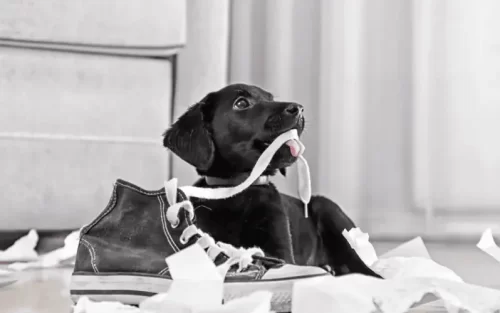
Preventing Chewing with Training and Management
In addition to addressing the root causes, you can use these tips to prevent your dog from chewing on inappropriate items:
- Dog-proof your home: Remove or secure tempting objects, such as shoes, children’s toys, and electronic cords, to minimize temptation. By putting away items that your dog is likely to chew on, you can help prevent accidents and damage.
- Redirect and praise: If you catch your dog chewing on something they shouldn’t, calmly redirect them to an appropriate chew toy and praise them when they switch. Positive reinforcement is crucial to help your dog understand which items are acceptable to chew on and which are not.
- Provide appropriate chew toys: Invest in durable, safe chew toys that can withstand your dog’s chewing power. Look for toys made from materials like tough rubber, nylon, or natural rubber, which can handle aggressive chewing. Rotate toys regularly to keep your dog interested and engaged.
- Use deterrent sprays: Apply a safe, bitter-tasting spray on items you want your dog to avoid. The unpleasant taste can discourage chewing. Use a non-toxic, pet-safe spray specifically designed to deter dogs from chewing.
- Crate training: If your dog only chews when left alone, crate training can be a valuable tool to prevent destructive chewing during your absence. A properly-sized crate can provide your dog with a safe, cozy space to relax while you’re away. Make sure to gradually acclimate your dog to the crate, and provide them with comfortable bedding, water, and a few toys to keep them occupied.
- Obedience training: Teaching your dog basic obedience commands, such as “leave it” or “drop it,” can help prevent inappropriate chewing. By reinforcing these commands, you can communicate with your dog more effectively and guide their behavior.
- Schedule routine checkups: Regular veterinary checkups can help identify and address any underlying medical issues contributing to your dog’s chewing habits. Dental problems, allergies, or gastrointestinal issues can sometimes lead to excessive chewing.
- Be patient and consistent: Changing your dog’s chewing behavior may take time, so your approach must be patient and consistent. Reward your dog for making the right choices and keep a consistent routine to reinforce good habits.
Conclusion
Preventing your dog from chewing on things requires understanding, patience, and consistency. By addressing the root causes, dog-proofing your home, and using training techniques, you can create a safe and happy environment for both you and your furry companion. Remember to consult with your veterinarian or a professional dog trainer if you’re struggling with your dog’s chewing habits, as they can provide tailored advice and solutions.
With time, effort, and a compassionate approach, you and your dog can enjoy a chew-free home, strengthening your bond and ensuring a harmonious living situation for all.
